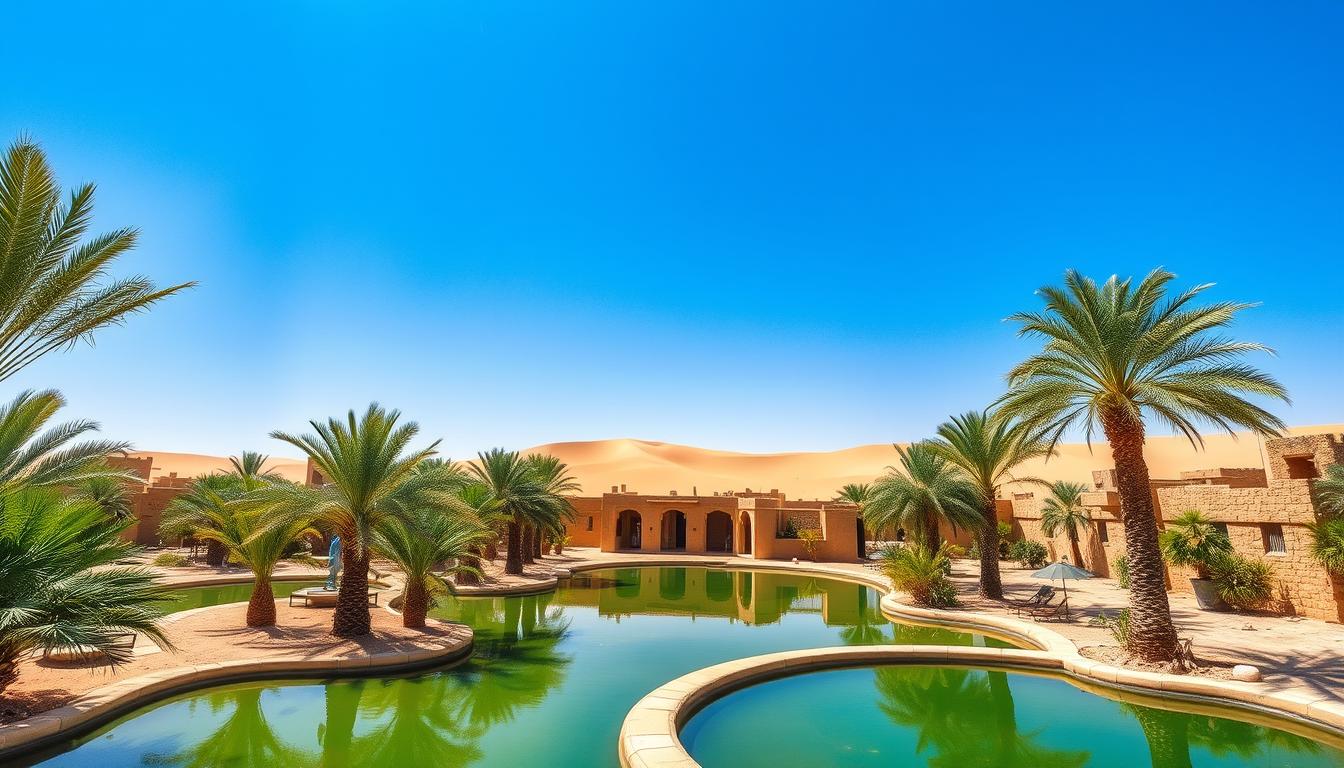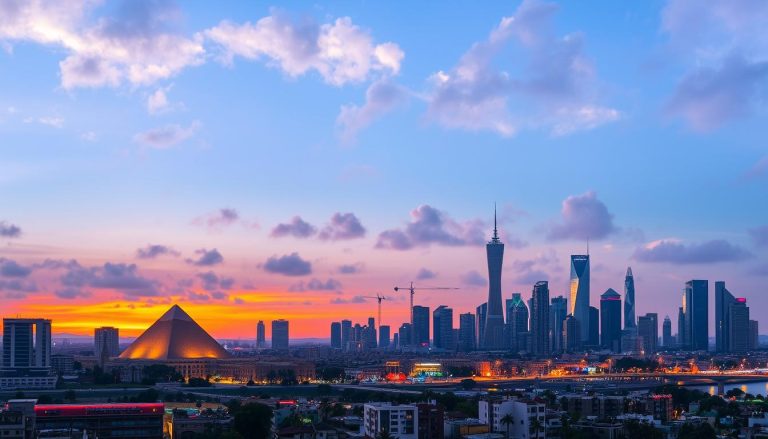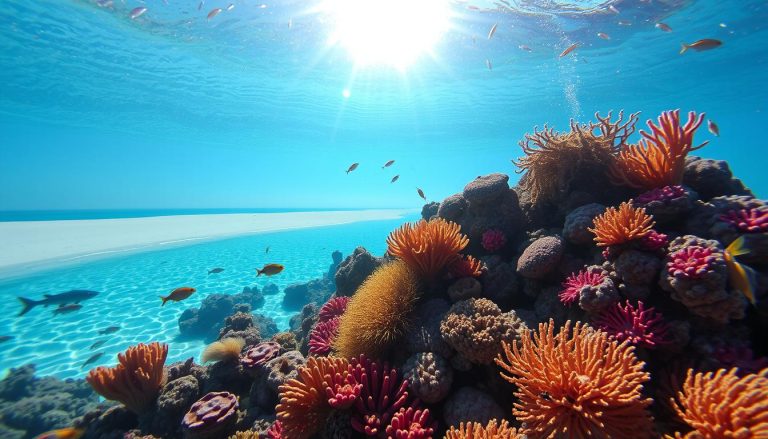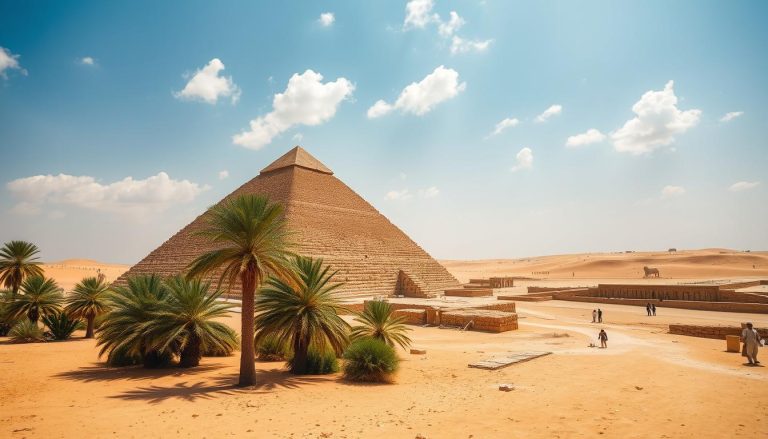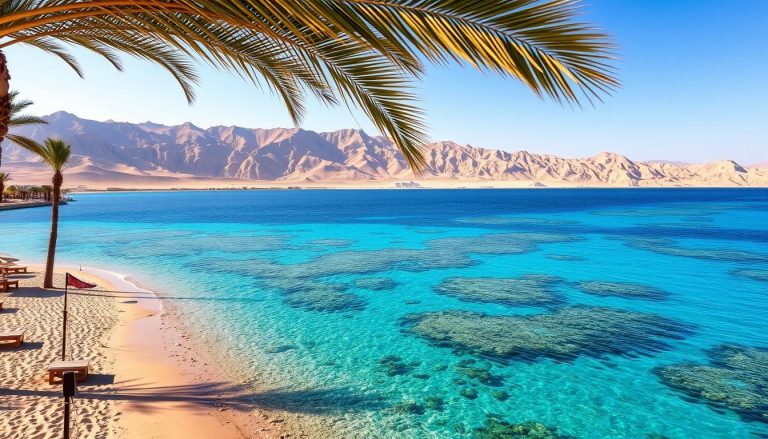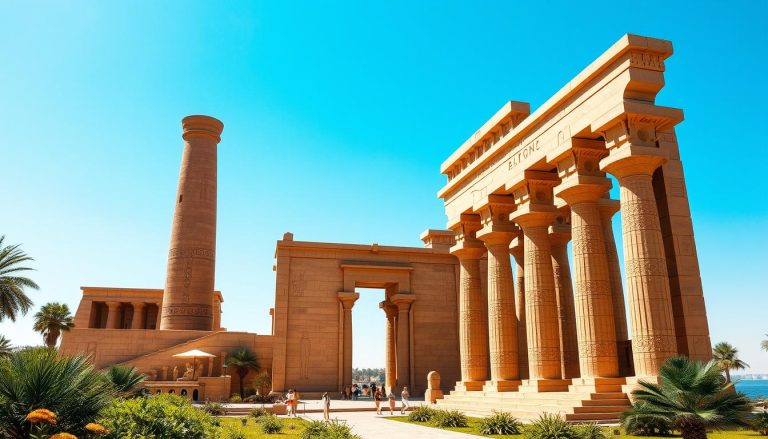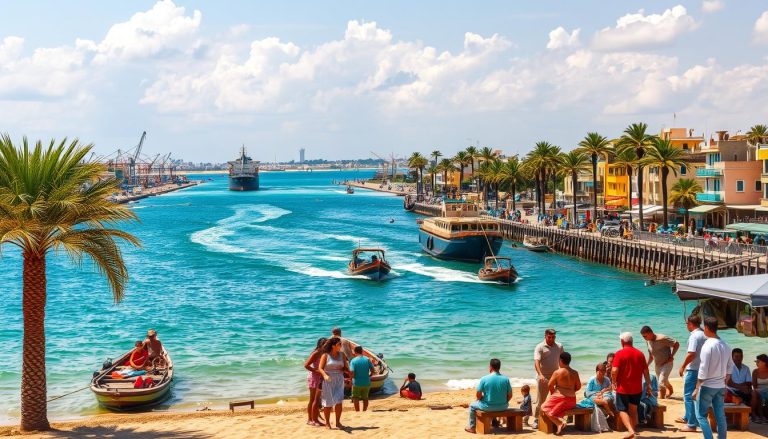The Kharga Oasis is in Egypt’s Western Desert. It’s a mix of natural beauty, ancient history, and culture. As Egypt’s biggest oasis, Kharga invites travelers with its landscapes, archaeological sites, and traditional life. What are the top attractions and activities in Kharga Oasis? Let’s find out why it’s a must-see in Egypt.
Why do tourists flock to Kharga Oasis, despite its remote spot? What ancient treasures and hidden gems await in Egypt’s desert? Let’s uncover the sights, experiences, and history that make Kharga Oasis special.
Key Takeaways
- Kharga Oasis is Egypt’s largest desert oasis, located 600 km southwest of Cairo.
- The oasis offers a unique blend of natural beauty, archaeological wonders, and rich cultural heritage.
- Explore lush palm groves, fertile agricultural lands, vast desert expanses, and historical sites from ancient Egypt to the Coptic period.
- Discover the oasis’s role in Egypt’s history and its significance as a strategic location along ancient trade routes.
- Uncover the best things to do in Kharga Oasis, from visiting the well-preserved Temple of Hibis to exploring the Christian cemetery of Bagawat.
Introduction to Kharga Oasis: Egypt's Largest Desert Oasis
The Kharga Oasis is in the Western Desert’s heart. It has a rich history and unique natural features. As Egypt’s biggest oasis, Kharga is key, linking the south to the north for ages.
Historical Significance
Kharga Oasis’s history goes back to the Middle Kingdom era. It was crucial for trade and commerce. Caravans passed through, connecting southern Africa to Egypt’s heart.
Geographical Location
Kharga Oasis is 232 km south of Asyut and 550 km south of Cairo. It’s in a big depression, 160 km long and 20-80 km wide. This makes Kharga Egypt’s largest desert oasis.
Climate and Natural Features
The climate is very dry, with an average temperature of 28°C. Despite the harsh weather, the oasis has many plants. You’ll find horn palm, acacia, and jujube trees, along with desert wildlife.
“Kharga Oasis is a true gem in the heart of Egypt’s Western Desert, offering a unique blend of historical significance and natural wonder.”
A Brief History Through Time: From Ancient Egypt to Modern Era
The Kharga Oasis in Egypt has a long and fascinating history. It spans thousands of years, from ancient pharaohs to today. This desert oasis was crucial for trade and a safe haven for many cultures.
In the 12th dynasty, people first found the Kharga Oasis. It became key for trade in the Old Kingdom. From the 13th to 17th dynasties, it grew as a center for farming and business.
In the Roman era, the oasis was a safe place for early Christians. They came here to escape persecution in the 3rd and 4th centuries AD. Today, you can see many archaeological sites from this time, like temples and churches.
The Kharga Oasis has seen many civilizations rise and fall. Each left behind a piece of their culture. You can see ancient Egyptian temples and well-kept Coptic churches here.
“The Kharga Oasis has been a witness to the ebb and flow of human civilization for millennia, a testament to the resilience and adaptability of the human spirit.”
Visiting the Kharga Oasis is like stepping into a history book. You’ll see how the Roman period and Coptic era meet ancient Egyptian wonders. This mix of cultures makes the oasis a must-see for history lovers.
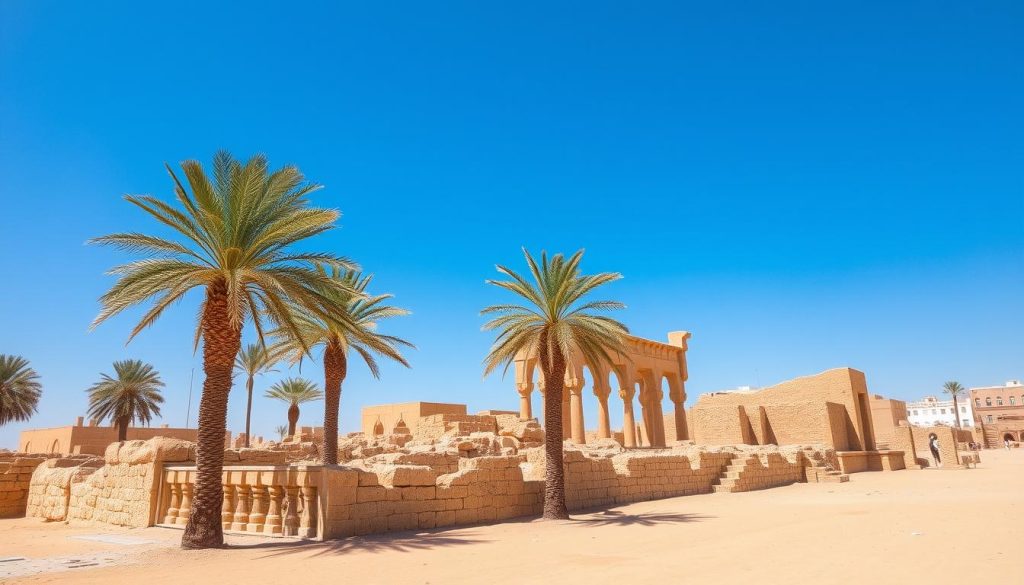
How to Get to Kharga Oasis
Getting to Kharga Oasis in Egypt’s Western Desert is easy. You can fly, drive, or use local transport. Each way offers a unique experience. Kharga is well-connected and easy to reach for visitors.
By Air Travel
A direct flight from Cairo to Kharga Oasis takes about 1 hour and 15 minutes. It’s a quick and comfortable way to get there. Flights leave Cairo in the morning and return in the afternoon, giving you time to explore.
By Road Transportation
Driving to Kharga Oasis is a great way to see more. Buses from Cairo, Luxor, and Assiut are cheap and take around 5 hours. Shared taxis and microbuses also offer a personal touch for trips around Kharga.
Local Transportation Options
- Green-and-white taxis are the main transport for tourists in Kharga. They’re comfy and efficient for local sightseeing.
- Shared microbuses, or “servees,” are cheaper for getting around the oasis.
- Private car rentals with a driver are perfect for adventure. They let you stop at interesting places along the way.
Choosing your transport to Kharga Oasis makes your journey fun. You’ll enjoy the beautiful landscapes and rich history of this desert gem.
The Temple of Hibis: Ancient Egypt's Best-Preserved Desert Temple
In the heart of Kharga Oasis, the Temple of Hibis shines as a gem of ancient Egyptian architecture. It’s the largest and most impressive desert temple in the region. It dates back to the 26th dynasty.
The temple honors Amun, Mut, and Khonsu, the Theban triad. It shows the skill and creativity of Egypt’s ancient builders. Its carvings, inscriptions, and architecture span many eras.
Visiting the Temple of Hibis is like stepping back in time. You’ll see amazing bas-relief carvings on the walls. They show scenes from ancient Egyptian life and rituals. The inscriptions give a peek into their beliefs and practices.
The temple is also a marvel of ancient Egyptian architecture. Its pylons, columns, and reliefs are awe-inspiring. It’s a must-see for anyone interested in history, architecture, or Egypt’s cultural heritage.
“The Temple of Hibis stands as a testament to the enduring legacy of ancient Egyptian civilization, offering a captivating glimpse into the past and leaving a lasting impression on all who witness its grandeur.”
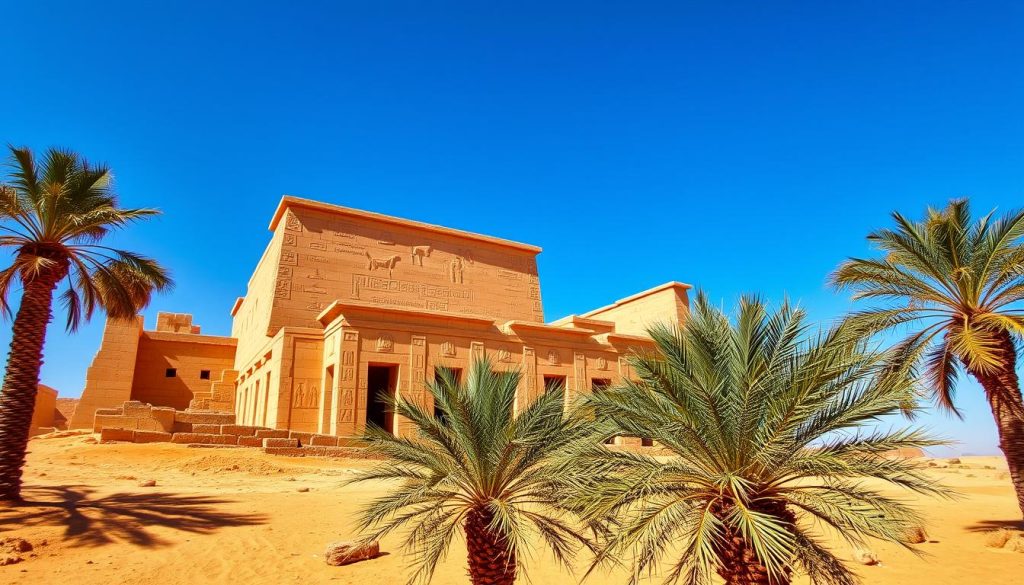
Exploring the Christian Heritage: Cemetery of Bagawat
The Cemetery of Bagawat is located 3 kilometers north of the Kharga Oasis in Egypt’s Western Desert. It’s a key part of the region’s Christian history. Built in the 7th century AD, it has 236 mud-brick tombs. Each tomb looks like a domed chapel and is covered in colorful Coptic frescoes and inscriptions.
Architectural Features
The Cemetery of Bagawat is famous for its unique architecture. The tombs are lined up in rows, with a central church in the middle. This layout makes the cemetery visually stunning and highlights its spiritual importance. The use of mud-brick and domed shapes adds to its timeless beauty.
Notable Tombs and Artwork
- The Exodus Tomb: This iconic tomb shows detailed biblical scenes, like the Israelites leaving Egypt.
- The Peace Tomb: It’s known for its stunning Coptic artwork. The artwork includes important religious figures and symbols, giving us a peek into the early Christian community in Kharga.
The Cemetery of Bagawat showcases the Christian heritage of the Kharga Oasis. It offers a look into the area’s rich cultural and religious past. With its impressive architecture and artwork, it’s a key site for those interested in Kharga’s history.
Ancient Roman Fortresses and Settlements
Kharga Oasis is a gem in Egypt’s Western Desert. It’s filled with ancient Roman ruins and settlements. Discover the history hidden in the desert.
Umm el-Dabadib Village
Visit the Umm el-Dabadib Village, covering 60,000 acres. It has square mudbrick towers. The Romans built this place, showing their skill in the desert.
Temple of Ghweita
The Temple of Ghweita is 25 km south of Kharga. It was for the Theban triad, powerful Egyptian gods. The temple’s art and design show the Romans’ religious life.
Temple of Qasr Al Zayyan
Head 5 km south of Ghweita to the Temple of Qasr Al Zayyan. It’s for Amun-Hibis, built from white limestone. The carvings and reliefs show the Romans’ artistic skill.
Exploring Kharga’s Roman ruins lets you dive into its history and culture. See how the Romans lived in the desert. Learn the stories hidden in these ruins.

“The desert is a magical place, where the vestiges of ancient civilizations stand as silent sentinels, whispering tales of a bygone era.”
Natural Wonders and Desert Landscapes
Kharga Oasis is in Egypt’s western desert. It’s a mix of natural beauty and geological wonders. It’s 2000 km from the Nile River valley and covers one-third of Egypt.
Visitors find peace in Kharga’s desert landscapes. They see tall sand dunes, rugged rocks, and palm trees. The climate is mild, with temperatures around 28°C and gentle winds.
The oasis is famous for its natural hot springs, like Bir Tarfawi. Here, travelers can relax in warm waters. They’re surrounded by the Sahara’s peaceful natural attractions.
Kharga is also home to many plants and animals. You can see buffalo thorn and various wildlife. It’s a chance to see the desert’s rich biodiversity.
“Exploring the Kharga desert landscapes is a truly mesmerizing experience, where the vastness of the Sahara meets the tranquility of an oasis.”
Kharga Oasis is perfect for those seeking peace, adventure, or natural wonders. It offers unforgettable experiences for all.
The Museum of Antiquities: A Journey Through Time
In the heart of Kharga Oasis, the Kharga Museum of Antiquities celebrates Egypt’s rich history. It houses a vast collection of treasures, giving visitors a peek into the past.
Exhibition Highlights
The museum’s exhibits are a sensory delight. Each piece is carefully preserved and displayed. You’ll see Pharaonic statues, Coptic pottery, and Pharaonic reliefs.
These artifacts show us what life was like in ancient times. They span from prehistoric eras to the Ottoman era.
Cultural Artifacts
The museum’s cultural artifacts are a highlight. They show the many influences on Kharga Oasis over the years. You’ll see jewelry, textiles, and household items that tell the region’s story.
The museum’s design, inspired by Al Bagawat Temple, adds to the experience. It feels like stepping back in time.
Whether you love history or just want to learn, the Kharga Museum of Antiquities is for you. Get ready to explore a world of archaeological treasures and ancient Egyptian artifacts.
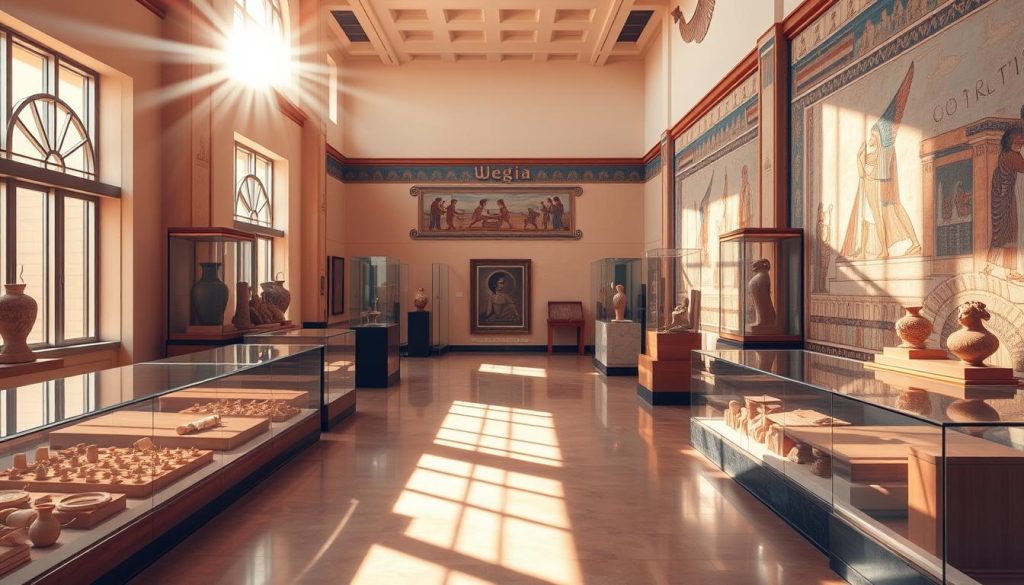
“The Kharga Museum of Antiquities is a veritable treasure trove, offering a unique and immersive glimpse into the region’s storied past. It’s a must-visit destination for anyone seeking to uncover the secrets of ancient Egypt.”
Local Culture and Traditional Life
Kharga Oasis is a unique desert region in Egypt’s Western Desert. It has a rich local culture shaped by history and nature. The people here have lived in this harsh environment for centuries, showing great resilience and creativity.
Traditional crafts are at the heart of Kharga’s culture. Visitors can see pottery-making, where artisans create beautiful pieces from clay. The vibrant textiles, made with natural dyes and patterns, are a highlight, showing the oasis’s textile heritage.
Agriculture is key in Kharga, with a focus on date palms. The palm groves provide food and show the people’s deep connection to the land. Visitors can see how dates are harvested and processed, learning about the oasis’s farming traditions.
The people of Kharga are known for their warm hospitality. Guests are welcomed and invited to join in local customs. Sharing meals and listening to local music make the cultural experience unforgettable.
“Kharga Oasis is a tapestry of history, tradition, and resilience, woven together by the enduring spirit of its people. To experience this captivating desert region is to uncover the enduring essence of Egypt’s timeless charm.”
Kharga Oasis offers a chance to explore crafts, agriculture, and local hospitality. It’s a place where you can truly connect with Egypt’s desert communities. This experience will leave you with a deep respect for their resilience and creativity.
Best Time to Visit and Practical Tips
The best time to visit Kharga Oasis is from October to April. Summers can get very hot, with temperatures over 40°C. You should wear sun protection and comfy shoes for the desert.
Book your stay and travel early, especially in busy seasons. This makes your visit to Kharga Oasis smooth.
Kharga Oasis is a fascinating spot in Egypt. It mixes ancient history, beautiful landscapes, and culture. To enjoy your trip, learn about local customs and some Arabic phrases.
Be ready to dive into the oasis tourism scene. With good Kharga travel tips and planning, you’ll explore this amazing oasis. You’ll discover its best season to visit secrets.
Egypt is a safe place for tourists. With help from local experts like Memphis Tours Egypt, your journey will be easy and rewarding. You’ll explore the heart of this desert oasis.
